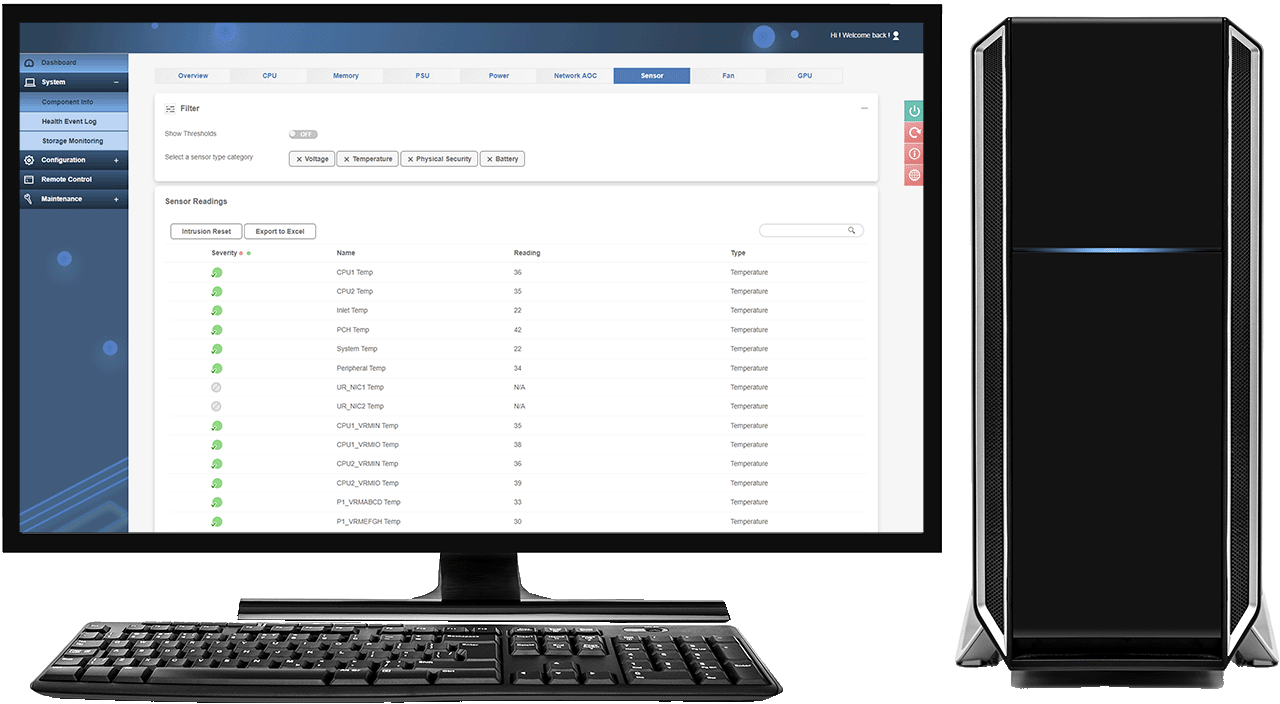Liquid Cooling
Revolutionizing Data Center Cooling
Liquid cooling emerges as a pivotal solution for data centers to manage the escalating heat from dense rack configurations and the demand for high computational power. This approach, integrating direct-to-chip and immersion techniques, surpasses traditional air cooling inefficiencies, catering to the latest advancements in Big Data, AI, and Edge Computing.

Liquid Cooling: A Future-Proof Solution for All Data Centers
The standardization of liquid cooling technology opens doors for its adoption across data centers of all sizes, including smaller HPC clusters. This evolution marks a significant leap towards enhancing efficiency, reducing costs, and supporting the computational demands of future technologies.
Liquid to Liquid Cooling
Direct Contact Liquid Cooling (DCLC): This method involves coolant being circulated directly through a heat sink attached to the CPU, GPU, or other heat-generating components. DCLC is highly effective in dissipating heat and is ideal for high-load servers.

Immersion Cooling
Immersion Cooling submerges electronics in a non-conductive liquid for efficient heat management, reducing energy use and enabling compact hardware arrangements. It combines superior cooling with environmental benefits, supporting both single-phase and two-phase processes for enhanced performance and longevity.

Air to Liquid Cooling
Air to Liquid Cooling transfers heat from components to a liquid, offering superior cooling efficiency and noise reduction compared to air cooling, ideal for managing high temperatures in electronic and industrial settings.

Cooling Innovation: Direct-to-Chip and Immersion Techniques
Offering flexibility in thermal management, liquid cooling divides into direct-to-chip and immersion categories. Both options provide scalable solutions for data centers, adapting to either single-phase or two-phase processes to efficiently dissipate heat.
Supermicro & NVIDIA CEOs about liquid cooling
Sustainability Through Advanced Cooling
Addressing the environmental impact, liquid cooling stands out by reducing energy consumption and operational costs associated with air conditioning in data centers. This method proves to be a sustainable choice, minimizing the carbon footprint while maximizing computational density and performance.
Liquid cooling is particularly beneficial for processing-intensive deployments
where space is a premium.
In summary, liquid cooling offers data centers a way to improve system performance, achieve energy
savings, enhance sustainability, and optimize space usage, marking a significant step forward in data center
technology.
Benefits of Liquid Cooling For Data Centers
High-Density Compatibility: Liquid cooling is ideal for high-density server setups where traditional air cooling is insufficient. It efficiently manages the heat generated by tightly packed hardware, maintaining optimal performance.
Targeted Cooling: Liquid cooling systems can be designed to target hotspots more effectively than air cooling, ensuring that the most heat-intensive components receive focused cooling attention.
Reduced Carbon Footprint: By lowering energy consumption, liquid cooling contributes to a reduced carbon footprint, aligning with green computing initiatives.
Water Conservation: Advanced liquid cooling systems, especially closed-loop designs, consume less water than traditional cooling towers, making them a more sustainable option.
Overclocking Potential: Liquid cooling can safely dissipate the additional heat generated by overclocking, allowing servers to run at higher speeds without the risk of overheating.
Compact Design: Liquid cooling systems can be more compact than bulky air coolers, freeing up space for other components or more streamlined server designs.
Visual Appeal: For environments where aesthetics matter, liquid cooling systems, with their tubes and coolants of various colors, can add a visually appealing element.
Improved Air Handling: By efficiently managing server heat, liquid cooling reduces hotspots within data centers, contributing to a more uniform and manageable environment temperature.
Reduced Dust and Debris: Unlike air cooling systems that can circulate and accumulate dust, liquid cooling systems are less prone to such issues, potentially reducing maintenance needs and prolonging equipment life.
Easily Scalable: Liquid cooling systems can be easily scaled to accommodate growing server needs, making them a future-proof solution for expanding businesses.
Versatility: They can be adapted for various applications, from small edge servers to massive data centers.
Quieter Operation: Liquid cooling systems produce significantly less noise compared to fans in air cooling systems, resulting in a quieter work environment.
Stable Operating Temperatures: Liquid cooling maintains a more consistent operating temperature, enhancing overall system stability and reliability, crucial for mission-critical applications.
Efficiency and Performance: The Liquid Cooling Advantage
The shift towards liquid cooling is justified by its significant efficiency and ability to handle the thermal output of powerful processors necessary for modern computing tasks. This necessity is underscored by the processors' intense heat generation, which traditional air cooling methods struggle to manage effectively.




Schrijf in voor onze Nieuwsbrief
Hebt u vragen of hulp nodig? Wij helpen u graag.
